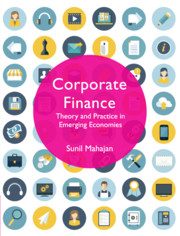Book contents
- Frontmatter
- Contents
- List of Figures
- List of Tables
- List of Corporate Snippets
- List of Abbreviations
- Preface
- Acknowledgements
- 1 Corporate Finance: A Conceptual Introduction
- 2 Financial Markets
- 3 The Time Value of Money
- 4 Capital Budgeting
- 5 Risk and Return
- 6 Valuation
- 7 Capital Structure and Financing
- 8 Dividend Payout: Policy and Practices
- 9 Leverage
- 10 Financial Derivatives
- 11 International Finance
- 12 Working Capital
- 13 Ratio Analysis
- Appendix
- Bibliography
- Index
9 - Leverage
Published online by Cambridge University Press: 30 April 2020
- Frontmatter
- Contents
- List of Figures
- List of Tables
- List of Corporate Snippets
- List of Abbreviations
- Preface
- Acknowledgements
- 1 Corporate Finance: A Conceptual Introduction
- 2 Financial Markets
- 3 The Time Value of Money
- 4 Capital Budgeting
- 5 Risk and Return
- 6 Valuation
- 7 Capital Structure and Financing
- 8 Dividend Payout: Policy and Practices
- 9 Leverage
- 10 Financial Derivatives
- 11 International Finance
- 12 Working Capital
- 13 Ratio Analysis
- Appendix
- Bibliography
- Index
Summary
Give me a lever long enough and a fulcrum on which to place it, and I shall move the earth.
—ArchimedesIn physics, leverage is a device to increase force at the cost of greater movement. Companies use leverage to increase profits while being exposed to a higher risk. Leverage uses the concept of fixed and variable costs to understand the impact of a company's cost structure on its return and risk.
Fixed costs do not vary with a change in the volume of production; they stay constant at different levels of production. If the fixed costs at 100 units are X, even at 101 units of production, the fixed costs incurred by the company remain X. Its significance lies in the fact that this leads to a change in the per unit fixed cost. If the production level increases, the same fixed costs are allocated over a larger number of units, leading to a lower cost of production for each unit of output. Managerial remuneration, insurance, interest and depreciation are examples of costs which are fixed. Depending on the nature of a specific industry, some other costs may also be fixed. For example, a flight from Mumbai to Delhi will incur fixed fuel and personnel expenses whether there are 153 or 154 passengers. The additional passenger does not add to the flying cost.
Variable costs vary with the level of output. In general, the per unit cost remains constant irrespective of the level of output. Variable costs include raw material and wages.
Thus, as the level of output increases, while the per unit variable cost remains constant, the per unit fixed cost reduces, leading to a fall in the total cost of each unit of output. This has the potential to increase profits disproportionately at higher level of sales.
In Table 9.1, firm F has low variable costs but high fixed costs. At low level of sales (₹50,000), it incurs operating losses of ₹45,000, being unable to cover the high fixed costs. But when the sales are high (₹200,000), the profits earned are huge at ₹60,000.
In comparison, Firm V has high variable costs and low fixed costs. Even at a low level of sales (₹50,000), the company does not incur a loss. At the same time, when sales shoot up to ₹200,000, it makes a profit of only ₹30,000.
- Type
- Chapter
- Information
- Corporate FinanceTheory and Practice in Emerging Economies, pp. 233 - 238Publisher: Cambridge University PressPrint publication year: 2020



